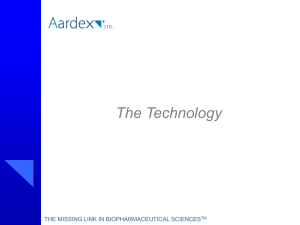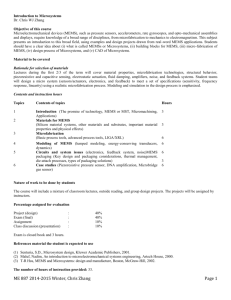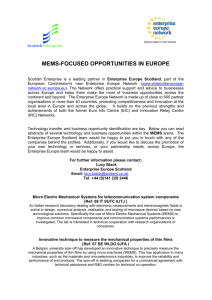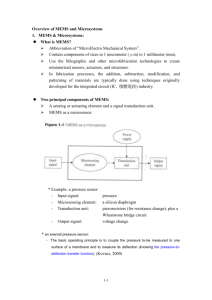BME/EE 446: Introduction to MEMS (Microelectromechanical Systems)
advertisement
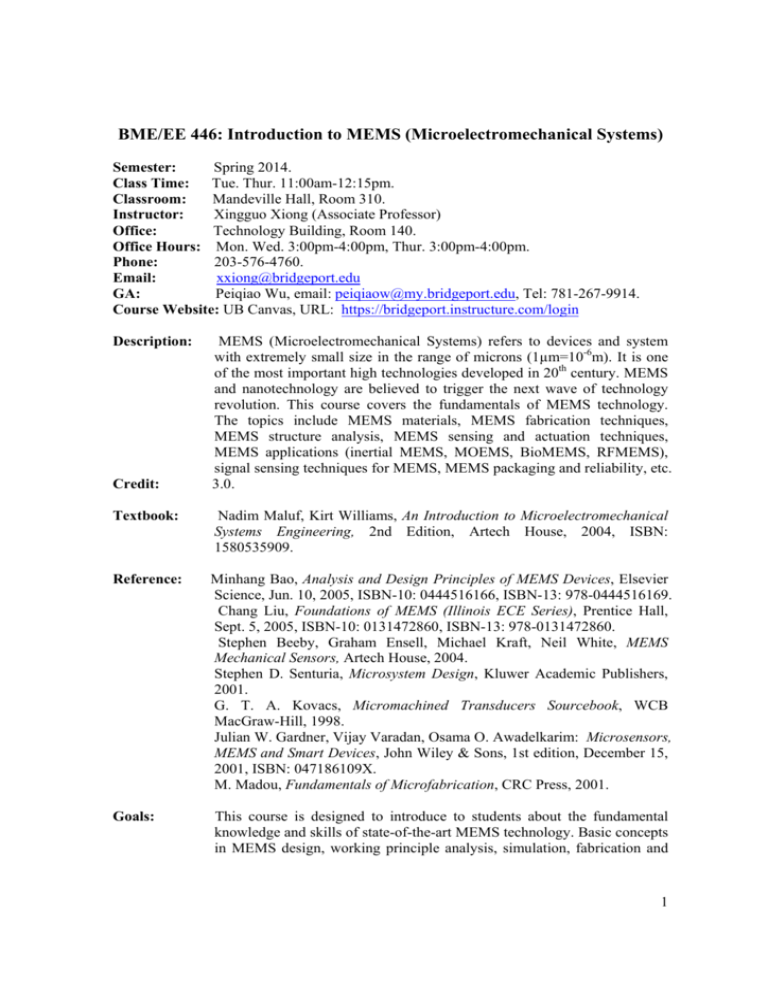
BME/EE 446: Introduction to MEMS (Microelectromechanical Systems) Semester: Spring 2014. Class Time: Tue. Thur. 11:00am-12:15pm. Classroom: Mandeville Hall, Room 310. Instructor: Xingguo Xiong (Associate Professor) Office: Technology Building, Room 140. Office Hours: Mon. Wed. 3:00pm-4:00pm, Thur. 3:00pm-4:00pm. Phone: 203-576-4760. Email: xxiong@bridgeport.edu GA: Peiqiao Wu, email: peiqiaow@my.bridgeport.edu, Tel: 781-267-9914. Course Website: UB Canvas, URL: https://bridgeport.instructure.com/login Description: Credit: MEMS (Microelectromechanical Systems) refers to devices and system with extremely small size in the range of microns (1µm=10-6m). It is one of the most important high technologies developed in 20th century. MEMS and nanotechnology are believed to trigger the next wave of technology revolution. This course covers the fundamentals of MEMS technology. The topics include MEMS materials, MEMS fabrication techniques, MEMS structure analysis, MEMS sensing and actuation techniques, MEMS applications (inertial MEMS, MOEMS, BioMEMS, RFMEMS), signal sensing techniques for MEMS, MEMS packaging and reliability, etc. 3.0. Textbook: Nadim Maluf, Kirt Williams, An Introduction to Microelectromechanical Systems Engineering, 2nd Edition, Artech House, 2004, ISBN: 1580535909. Reference: Minhang Bao, Analysis and Design Principles of MEMS Devices, Elsevier Science, Jun. 10, 2005, ISBN-10: 0444516166, ISBN-13: 978-0444516169. Chang Liu, Foundations of MEMS (Illinois ECE Series), Prentice Hall, Sept. 5, 2005, ISBN-10: 0131472860, ISBN-13: 978-0131472860. Stephen Beeby, Graham Ensell, Michael Kraft, Neil White, MEMS Mechanical Sensors, Artech House, 2004. Stephen D. Senturia, Microsystem Design, Kluwer Academic Publishers, 2001. G. T. A. Kovacs, Micromachined Transducers Sourcebook, WCB MacGraw-Hill, 1998. Julian W. Gardner, Vijay Varadan, Osama O. Awadelkarim: Microsensors, MEMS and Smart Devices, John Wiley & Sons, 1st edition, December 15, 2001, ISBN: 047186109X. M. Madou, Fundamentals of Microfabrication, CRC Press, 2001. Goals: This course is designed to introduce to students about the fundamental knowledge and skills of state-of-the-art MEMS technology. Basic concepts in MEMS design, working principle analysis, simulation, fabrication and 1 testing will be introduced. MEMS industrial applications in various areas will be discussed. The course project will give students hands-on experience in MEMS device design and simulation. Upon finishing the course, students will have a fundamental understanding about MEMS design, simulation, fabrication and testing. Prerequisites: Undergraduate and graduate students with engineering or physics background. Only basic knowledge in undergraduate mechanics and mathematics are required. Topics: 1. Introduction to MEMS. 2. MEMS materials and their properties. 3. Fabrication of MEMS: micromachining. 4. MEMS Structure Analysis. 5. MEMS Sensing and Actuation Techniques. 6. MEMS for automotive/aerospace applications (Inertial MEMS). 7. MEMS CAD design and simulation (ANSYS). 8. MEMS for photonic applications (Micro-Opto-Electro-Mechanical Systems, MOMES). 9. MEMS for biological applications (BioMEMS). 10. MEMS for RF communication applications (RFMEMS). 11. MEMS packaging and reliability considerations. 12. MEMS fault testing. Grading: Exams The final grade will be 15% on homework, 15% on projects, 31% on midterm exam, 35% on final exam and 4% on attendance. There will be four random attendance, each will count 1 credit in your final grade. There will be two exams: the mid-term exam and the final exam. Computer Usage: PC (ANSYS software). Lab Project: Three lab projects on MEMS devices design and simulation will be assigned. The goal of the projects is to help student accumulate skills and experience in MEMS CAD design and simulation. Students will use CAD tools (ANSYS) to build the device model, and simulate its response to input stimulus. ANSYS software is installed in department computer lab. ANSYS software tutorials will be given before the projects. Through these projects, students will get familiar with MEMS device design, analysis and function simulation. Cheating Policy: It is the student’s responsibility to familiarize himself or herself with and adhere to the standards set forth in the policies on cheating and plagiarism as defined in Chapters 2 and 5 of the Key to UB (http://www.bridgeport.edu/pages/2623.asp) or the appropriate graduate program handbook. 2


